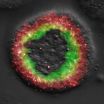(Press-News.org) A team of researchers at the Medical College of Wisconsin and Children's Hospital of Wisconsin Research Institute defined a new treatment for a potentially fatal lung disease in patients with a primary immunodeficiency known as common variable immunodeficiency (CVID).The findings are published in the Journal of Clinical Immunology.
Common variable immunodeficiency (CVID) is the most common primary immunodeficiency that requires regular treatment with medication, specifically immunoglobulin (antibodies) replacement therapy. With immunoglobulin therapy, deaths from infection in patients with CVID have decreased and deaths due to non-infectious complications have increased. One of the most frequent causes of death now in CVID is a lung disease known as granulomatous-lymphocytic interstitial lung disease (GLILD). In GLILD, white blood cells abnormally accumulate in the lung, which leads to a progressive decline in lung function and, eventually, respiratory failure. The researchers evaluated patients with GLILD to see if rituximab and azathioprine (combination chemotherapy) would improve pulmonary function and/or radiographic abnormalities by killing these white blood cells in the lung.
"The most common medication used for GLILD are corticosteroids but in our hands this type of medication did not clear the disease. Therefore, we designed therapy aimed at killing the specific type of lymphocytes, B cells and T cells, we found in abnormal numbers in the lung biopsies we examined. We reasoned if we killed the lymphocytes in the lung, lung function and radiographic abnormalities would both improve, which is what we found." said John M. Routes, M.D., professor and chief of asthma, allergy and immunology at the Medical College of Wisconsin (MCW), medical director of allergy/clinical immunology at Children's Hospital and researcher at the Research Institute.
###
Other authors of the paper include Nicole M. Chase, M.D.; James W. Verbsky, M.D., Ph.D.; Mary K. Hintermeyer, A.P.N.P.; Jill K. Waukau, B.S.; Aoy Tomita-Mitchell, Ph.D.; James T. Casper, M.D.; Sumit Singh, M.D.; Kaushik S. Shahir, M.D.; William B. Tisol, M.D.; Melodee L. Nugent, M.A.; R. Nagarjun Rao, M.D.; A. Craig Mackinnon, M.D., Ph.D.; Lawrence R. Goodman, M.D.; and Pippa M. Simpson, M.D.; MCW, Children's Hospital and the Research Institute.
About the Medical College of Wisconsin
The Medical College of Wisconsin is the state's only private medical school and health sciences graduate school. Founded in 1893, it is dedicated to leadership and excellence in education, patient care, research and service. More than 1,200 students are enrolled in the Medical College's medical school and graduate school programs. A major national research center, it is the largest research institution in the Milwaukee metro area and second largest in Wisconsin. In FY 2010 – 11, faculty received more than $175 million in external support for research, teaching, training and related purposes, of which more than $161 million is for research. This total includes highly competitive research and training awards from the National Institutes of Health (NIH). Annually, College faculty direct or collaborate on more than 2,200 research studies, including clinical trials. Additionally, more than 1,350 physicians provide care in virtually every specialty of medicine for more than 400,000 patients annually.
About Children's Hospital of Wisconsin
Children's Hospital of Wisconsin is the region's only independent health care system dedicated solely to the health and well-being of children. The hospital, with locations in Milwaukee and Neenah, Wis. is recognized as one of the leading pediatric health care centers in the United States. Children's Hospital provides primary care, specialty care, urgent care, emergency care, community health services, foster and adoption services, child and family counseling, child advocacy services and family resource centers. In 2010, Children's Hospital invested more than $105 million in the community to improve the health status of children through medical care, advocacy, education and pediatric medical research. Children's Hospital achieves its mission in part through donations from individuals, corporations and foundations and is proud to be a Children's Miracle Network Hospital. For more information, visit the website at chw.org.
Immunodeficient patients with secondary lung disease benefit from combined chemotherapy
2012-08-30
ELSE PRESS RELEASES FROM THIS DATE:
A model for development
2012-08-30
PASADENA, Calif.—As an animal develops from an embryo, its cells take diverse paths, eventually forming different body parts -- muscles, bones, heart. In order for each cell to know what to do during development, it follows a genetic blueprint, which consists of complex webs of interacting genes called gene regulatory networks.
Biologists at the California Institute of Technology (Caltech) have spent the last decade or so detailing how these gene networks control development in sea-urchin embryos. Now, for the first time, they have built a computational model of one ...
Does wisdom really come with age? It depends on the culture
2012-08-30
"Wisdom comes with winters," Oscar Wilde once said. And it's certainly comforting to think that aging benefits the mind, if not the body. But do we really get wiser as time passes?
There are many way to define what exactly wisdom is, but previous literature suggests that having wisdom means that you are also good at resolving conflict. But conflict is not handled the same way across cultures. Americans have been shown to emphasize individuality and solve conflict in a direct manner, such as by using direct persuasion. In contrast, the Japanese place a greater emphasis ...
Viruses could be the key to healthy corals
2012-08-30
Corals are an invaluable part of the marine ecosystem, fostering biodiversity and protecting coastlines. But they're also increasingly endangered. Pathogenic bacteria, along with pollution and harmful fishing practices, are one of the biggest threats to the world's coral populations today.
One of the solutions to the crisis may lie in human medicine. Prof. Eugene Rosenberg of Tel Aviv University's Department of Molecular Microbiology and Biotechnology, working in collaboration with Dr. Ilil Atad of his own laboratory and Prof. Yossi Loya of TAU's Department of Zoology, ...
No-till farming helps capture snow and soil water
2012-08-30
A smooth blanket of snow in the winter can help boost dryland crop productivity in the summer, and no-till management is one way to ensure that blanket coverage, according to U.S. Department of Agriculture (USDA) research.
Agricultural Research Service (ARS) soil scientist David Huggins conducted studies to determine how standing crop residues affect snow accumulation and soil water levels across entire fields. ARS is USDA's chief intramural scientific research agency, and this work supports the USDA priority of responding to climate change.
Huggins, who works at ...
'Hulk' protein, Grb10, controls muscle growth
2012-08-30
Bethesda, MD — Scientists have moved closer toward helping people grow big, strong muscles without needing to hit the weight room. Australian researchers have found that by blocking the function of a protein called Grb10 while mice were in the womb, they were considerably stronger and more muscular than their normal counterparts. This discovery appears in the September 2012 issue of The FASEB Journal. Outside of aesthetics, this study has important implications for a wide range of conditions that are worsened by, or cause muscle wasting, such as injury, muscular dystrophy, ...
Wayne State's new flexible electronics technology may lead to new medical uses
2012-08-30
DETROIT — A Wayne State University researcher has developed technology that opens new possibilities for health care and medical applications of electronic devices.
Yong Xu, associate professor of electrical and computer engineering in the College of Engineering, has developed a simple technology compatible with silicon-on-insulator (SOI) complementary-metal-oxide-semiconductor (CMOS) processes for making flexible electronics. "A Silicon-On-Insulator Complementary-Metal-Oxide-Semiconductor Compatible Flexible Electronics Technology," published recently in Applied Physics ...
New research uncovers diverse metabolic roles for PML tumor suppressor gene
2012-08-30
BOSTON -- Two papers led by scientific teams from the Cancer Genetics Program at Beth Israel Deaconess Medical Center (BIDMC) shed new light on the genetic mechanisms underlying cellular energy and metabolism and, at the same time, highlight both the challenges and opportunities of genetic approaches to cancer treatment.
Appearing in the September 2012 issues of The Journal of Clinical Investigation (JCI) and Nature Medicine, the new findings reveal surprising insights into how PML regulates metabolism via the fatty acid oxidation (FAO) pathway and, in the process, uncover ...
A surprisingly bright superbubble
2012-08-30
This composite image shows a superbubble in the Large Magellanic Cloud (LMC), a small satellite galaxy of the Milky Way located about 160,000 light years from Earth.
Many new stars, some of them very massive, are forming in the star cluster NGC 1929, which is embedded in the nebula N44, so named because it is the 44th nebula in a catalog of such objects in the Magellanic Clouds. The massive stars produce intense radiation, expel matter at high speeds, and race through their evolution to explode as supernovas. The winds and supernova shock waves carve out huge cavities ...
Smartphone app can track objects on the battlefield as well as on the sports field
2012-08-30
COLUMBIA, Mo. -- University of Missouri researchers have developed new software using smartphones' GPS and imaging abilities, that determine the exact location of distant objects as well as monitor the speed and direction of moving objects. The software could eventually allow smartphone-armed soldiers to target the location of their enemies. On the home front, the software could be used by everyone, including golfers judging distance to the green and biologists documenting the location of a rare animal without disturbing it.
"The great advantage of a smartphone is that ...
Los Alamos provides HOPE for radiation belt storm probes
2012-08-30
LOS ALAMOS, N.M., August 30, 2012 — Los Alamos National Laboratory expertise in radiation detection and shielding is poised to help a national team of scientists better understand a mysterious region that can create hazardous space weather near our home planet.
The Helium Oxygen Proton Electron (HOPE) analyzer is one of a suite of instruments that was successfully launched today as part of the Radiation Belt Storm Probe mission—an effort by NASA and the Johns Hopkins University's Applied Physics Laboratory to gain insight into the Sun's influence on Earth and near-Earth ...

